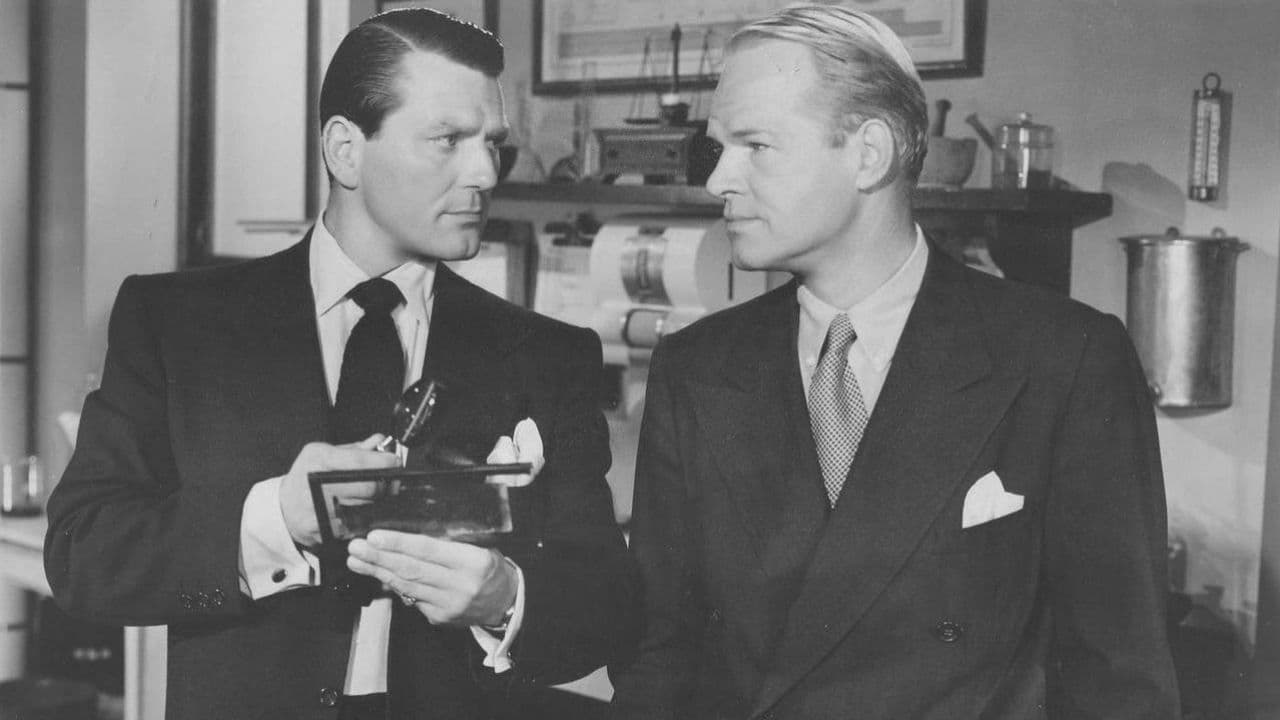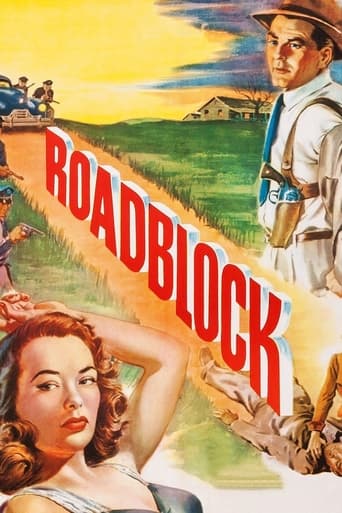



Really Surprised!
Let's be realistic.
A Disappointing Continuation
The film makes a home in your brain and the only cure is to see it again.
View MoreRoadblock is the story of PI Charles McGraw who's a clever but honest detective on retainer for an insurance company. Circumstances on a return flight to his home base in Los Angeles throw him together with Joan Dixon who makes no mistake about the fact she's high maintenance.What to do to win her was throw in with well known but untouchable crook Lowell Gilmore to do a heist on a mail train carrying lots of untracealbe currency. No fence means they take it all. Of course as things happen stuff goes wrong and McGraw in the end becomes a hunted man. Situation similar to the Humphrey Bogart faced in High Sierra with the law closing in.McGraw is fine in a role perfectly suited to him. Dixon's somewhat abrupt change of character is the main problem I have with Roadblock. It makes no sense at all.Still some nice action shots and that final chase in the dry Los Angeles River bed is one of the best of its kind on film. Gives Bullitt a run for its money.
View More'Roadblock (1951)' has plenty of the classic noir ingredients, but it also recalls all those films from which it borrowed them. An honest insurance detective is corrupted into defrauding his own employer – that's straight from 'Double Indemnity (1944).' A swift city-wide dragnet embraces the fleeing anti-hero, stifling his final chance of escape – that's 'High Sierra (1941).' Even leading man Charles McGraw, typically confined to supporting roles, might credibly be described as a "poor man's Kirk Douglas." With his chiselled features and a gravelly voice, I occasionally found myself picturing Douglas in the role (I also saw Gene Tierney in Joan Dixon's place, but that's just me and my wishful imagination). All things considered, the two main performers do quite well in a B-movie that offers few surprises. Content to follow the already-established film noir mould – to drive the riverbed without breaching its banks, so to speak – director Harold Daniels has produced an entertaining, workman-like thriller. But why rewatch it, especially when you can instead enjoy its superior predecessors?The film, intended as the lower half of a double-bill, jumps straight into action. A fugitive bank robber (Peter Brocco) becomes witness to a homicide, the killer taking him hostage and threatening to dispose of him. After offering his stolen loot in exchange for his life, the film pulls its first – and probably only – unexpected twist. The "killer" is, in fact, L.A. insurance detective Joe Peters (Charles McGraw), who engineered the mock murder of his partner (Louis Jean Heydt) to discover the whereabouts of the missing bank money. Peters is fiercely honest, having resigned himself to an unglamorous life on a modest detective's income, but this episode foreshadows his character's transformation into a liar, murderer and fugitive. Why do good men turn bad? In 'Roadblock' – as in all noir – the blame is irrevocably placed on a woman. Unashamed gold-digger Diane (Joan Dixon) taunts Peters with her icy beauty, disdainfully implying that he could never afford somebody like her on such a meagre salary. If you're going to turn to crime, I guess sex is as good a reason as any.'Roadblock' was directed by Harold Daniels, who doesn't appear to have much else of credit to his name, but the cinematography was by Nicholas Musuraca, whose exquisite noirish work is also on display in 'Stranger on the Third Floor (1940),' 'Cat People (1942)' and 'Out of the Past (1947).' What I love most about film noir is how the photography so often suggests more than would otherwise be understood. For example, despite beginning the film as a questionable, if seductive, chiseller, Joan Dixon's character later takes a turn towards the uninteresting, rejecting her former prestigious life-style in favour of love and marriage (making Peters' fatal transformation ironically unnecessary). Having now settled into her new role as a slighted romantic lover, and apparently deserving of our sympathy, Diane witnesses her husband gunned down by police, and resignedly departs the scene. It's not spoken, but Musuraca's camera doesn't forget who's to blame for this tragedy: he frames her strutting purposely - almost dismissively - away from the devastation her hand has caused, like a gunman turning his back on a massacre.
View MoreAre you tired of getting misinformation about "film noir" from people who think they know what they are talking about, but are clearly clueless on the concept? Most everyone has heard the term and most have a vague idea that it refers to a group of shadowy crime dramas (principally produced by Hollywood) from the 1940's and 1950's which include corruption as their main thematic element and sex as an audience draw. The shadowy cinematography grew out of a visual style that characterized German Expressionist cinema (realism that was not so much real as it was exaggerated). For most producers of these films, it was an unconscious style only identified by film historians in retrospect. Which means that any effective definition must be rather loose and most style inconsistencies simply accepted. It is broader than many realize, going from Billy Wilder (actually from the German cinema) stuff like "The Lost Weekend", to classic Chandler adaptations like "The Big Sleep", to Welles' "Touch of Evil". By accepted definition it stays in the crime genre (private eyes, police, social problems) but could sometimes cross into other genres.So just in case there is any confusion, "Roadblock" (1951) is clearly an example of "film noir", not just a good example of the style but a surprisingly entertaining film. It's a low-budget understated picture whose technical flaws and modest resources ironically enhance its most compelling feature, the distance of the self-discovery journey its two main characters traverse during the course of the story. What makes this spellbinding is that they begin on opposite extremes, move toward each other and then keep going until they actually end up beyond the other's starting position. To package a story of such a grand human scale, inside a modest little package, actually makes the story even more compelling as it adds to its allegorical theme and exaggerated expressionistic element.Joe Peters (Charles McGraw-a completely nondescript leading man) begins the story as a Joe Friday ultra straight arrow insurance investigator. He and his partner (Louis Jean Heydt) open the film with an ingenious ploy to force a robber to reveal the location of some stolen money for which their company is on the hook.Honest and ethical as the day is long, Joe at first seems drawn to strikingly beautiful femme fatale Diane (Joan Dixon) more by a sense of protectiveness than because of any physical attraction. Which is part of the genius of the casting, as McGraw was in his late thirties and Dixon had just turned 21. They first meet when Diane scams the airline for a half price first class ticket by claiming to be the wife of Joe Peters; revealed to Joe only after they are seated together on the plane. She is headed from Ohio to Los Angeles, where she intends to use her feminine charms to move up in class. Over the course of the first half of the film there are flirtatious advances by each of them, ending with the other saying "it takes two". But ultimately they connect and get married only to discover that in their movement to the center they have passed the point of intersecting belief systems and actually switched places. The young Dixon holds her own with McGraw and they effectively navigate the demands of playing characters whose principle characteristic is behaving out of character (huh?). Also well written are the elements surrounding the investigation of the train robbery which is solved by good plausible detective work rather than by a lucky break or an illogical character development. The last 20 minutes is a disappointment, as the film becomes a standard fugitive drama with no interesting twists. The device that leads to Joe's undoing has no symbolic significance inside the story and unlike the best of these things was not revealed in such a way that you could have foreseen its significance at the time it was first introduced. The low budget actually starts working against the production at this point as they stage some really lame car crash and chase sequences; finally ending up in the Los Angeles riverbed (a staple of 1950's productions-insert "Them" here). It does however provide a nice backdrop for the great closing shot (the shot they go out on), much like the way Polanski ends "Chinatown".The car crash that Joe stages to cover his tracks is a brief bit of stock footage that bears no relationship to the setting or vehicle he sets up for the crash. This is inexplicable given that we are not talking about anything that would have taken a huge budget to stage realistically, and the producers missed an opportunity to showcase something visually interesting.The weakest thing is crime boss Kendall Webb (Lowell Gilmore), a finishing school, smoking jacket style crime boss who at one point waxes on nostalgically about growing up juvenile detention facilities. You have to wonder why they didn't simply alter the script a bit to give Gilmore lines that were at least vaguely consistent with the way in which the director was having him play his character. If not it should have been trimmed during the editing process. Speaking of editing, watch for the glaring jump cut when Joe and Diane are talking to each other on the plane. If the production crew failed to get adequate coverage the editor should have cut-away to an ashtray or something; even a few frames of black would have been better than what was actually assembled.Then again, what do I know? I'm only a child.
View MoreDrop a laurel wreath on Charles McGraw's huge, sculptural head you can almost see it in the Greco-Roman wing of a museum, perched atop a pedestal. He was one of the noir cycle's most serviceable pieces of furniture, along with Raymond Burr and Elisha Cook, Jr. Most often he lurked in the murky background, but sometimes, most memorably in The Narrow Margin, he stayed front and center. He also shuttled uncomplainingly between the underworld and the keepers of law and order. Starring in Roadblock, he tries to straddle both worlds.This no-frills noir opens with a tease: McGraw stages a murder, then abducts a witness whom he manipulates into buying his way out of certain death with the loot from a bank job. But the movie is setting up McGraw as a straight-arrow insurance investigator who'll stop at nothing to achieve his goal.Until he crosses paths with Joan Dixon, that is. A crafty gold-digger, she finds him sweet but `honest;' she's saving her sexual artillery for more affluent game, which she finds in a smooth racketeer (Lowell Gilmore). But McGraw can't get her out of his blood and, knowing that furs and jewels are the path to her mercenary heart, strikes up a deal with the mobster. He offers him a million-and-a-quarter, insured by his company, which he knows will be traveling by train; if Gilmore pulls the job off, McGraw will settle for $400 grand.The irony and the script's least convincing turn is that Dixon falls for McGraw anyway and renounces her grasping ways. (Not only does this ring false, it also makes her far less arresting a character.) Despite second thoughts, McGraw gets his share of the take. Then, naturally, he's assigned to the team of investigators trying to crack the case....Harold Daniels, who had a brief and largely undistinguished career as both actor and director, keeps the action swift and simple it races down an hour-plus of highway until it reaches its titular roadblock. The movie goes down as easily and satisfyingly as a hot dog and a beer.
View More